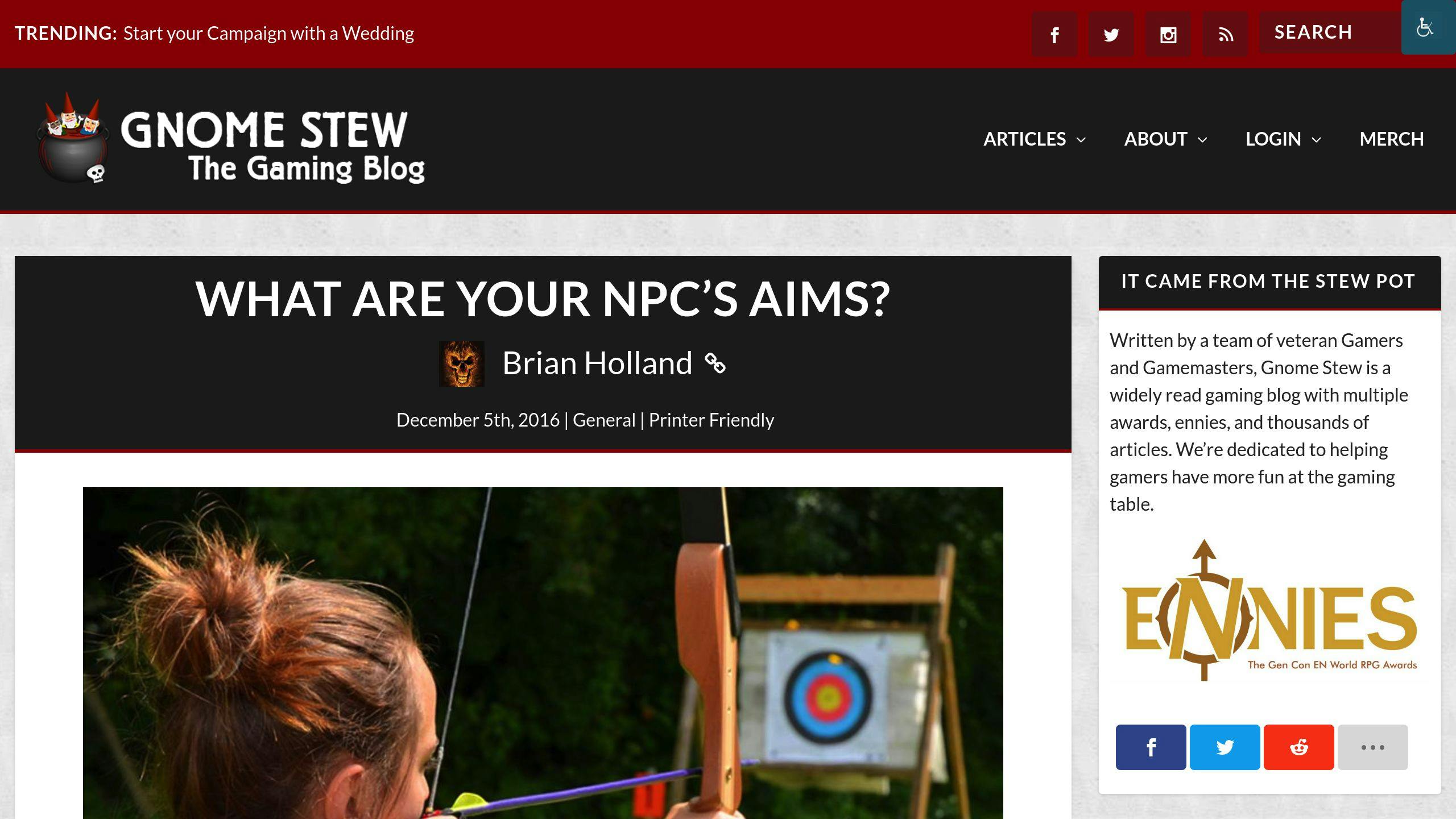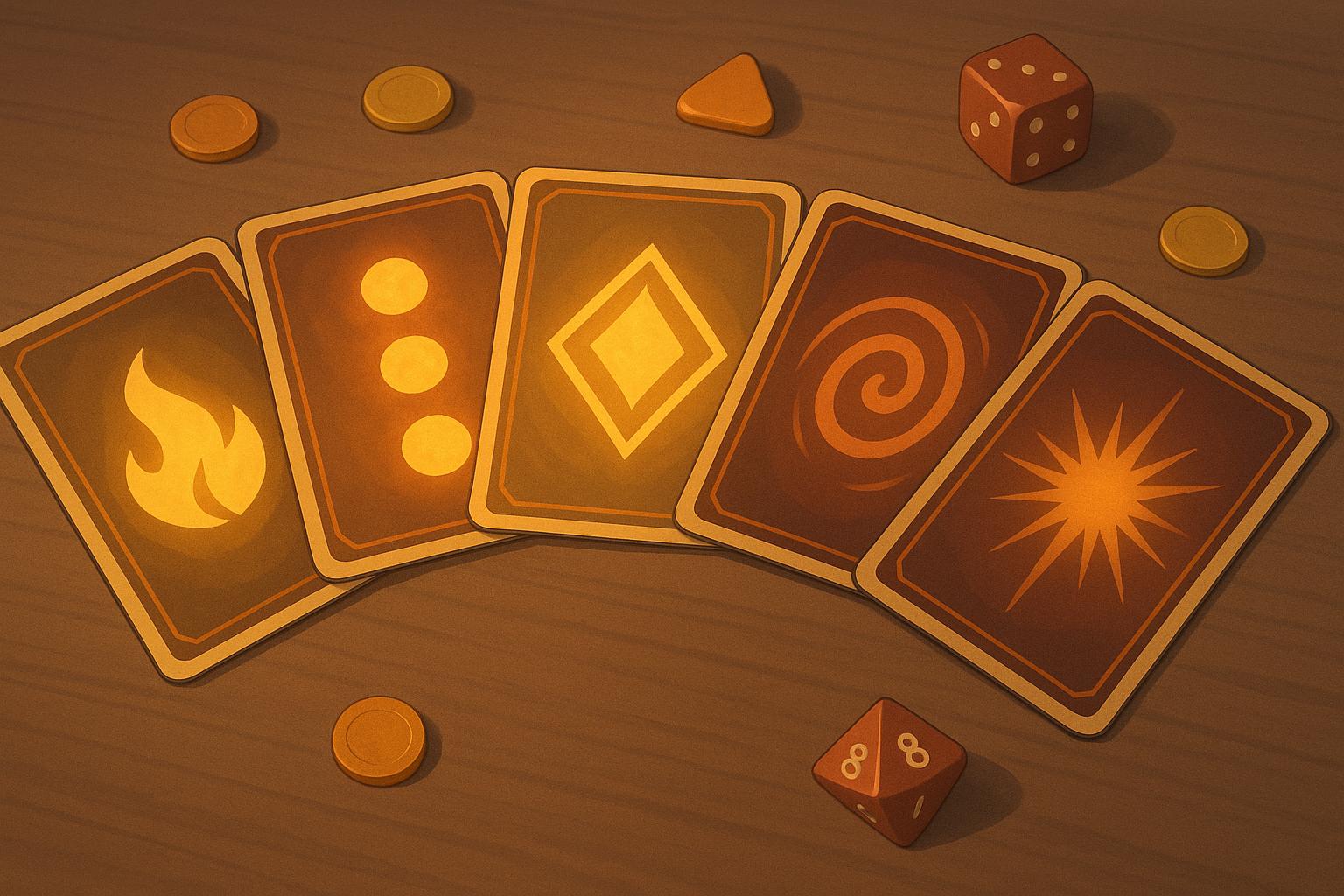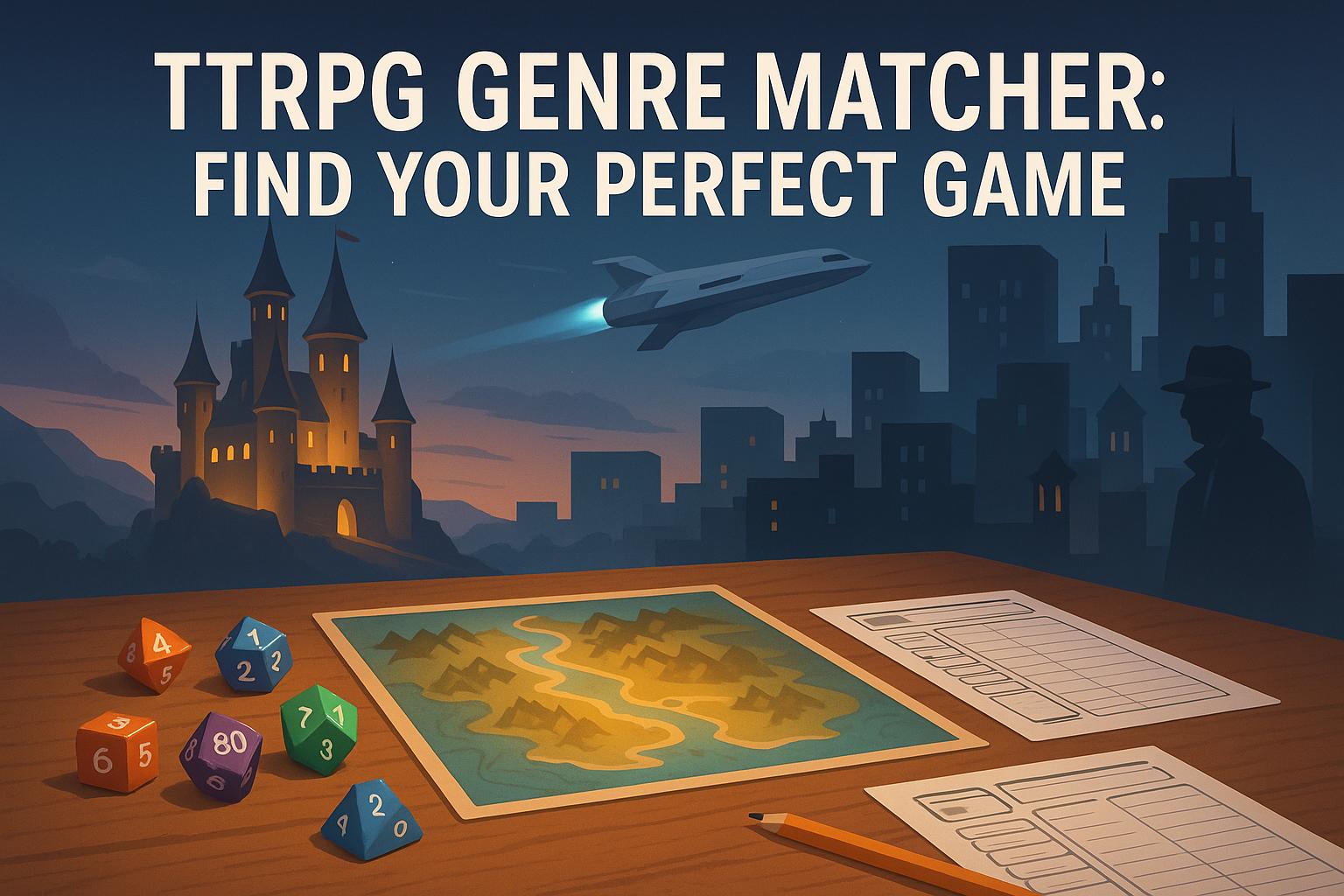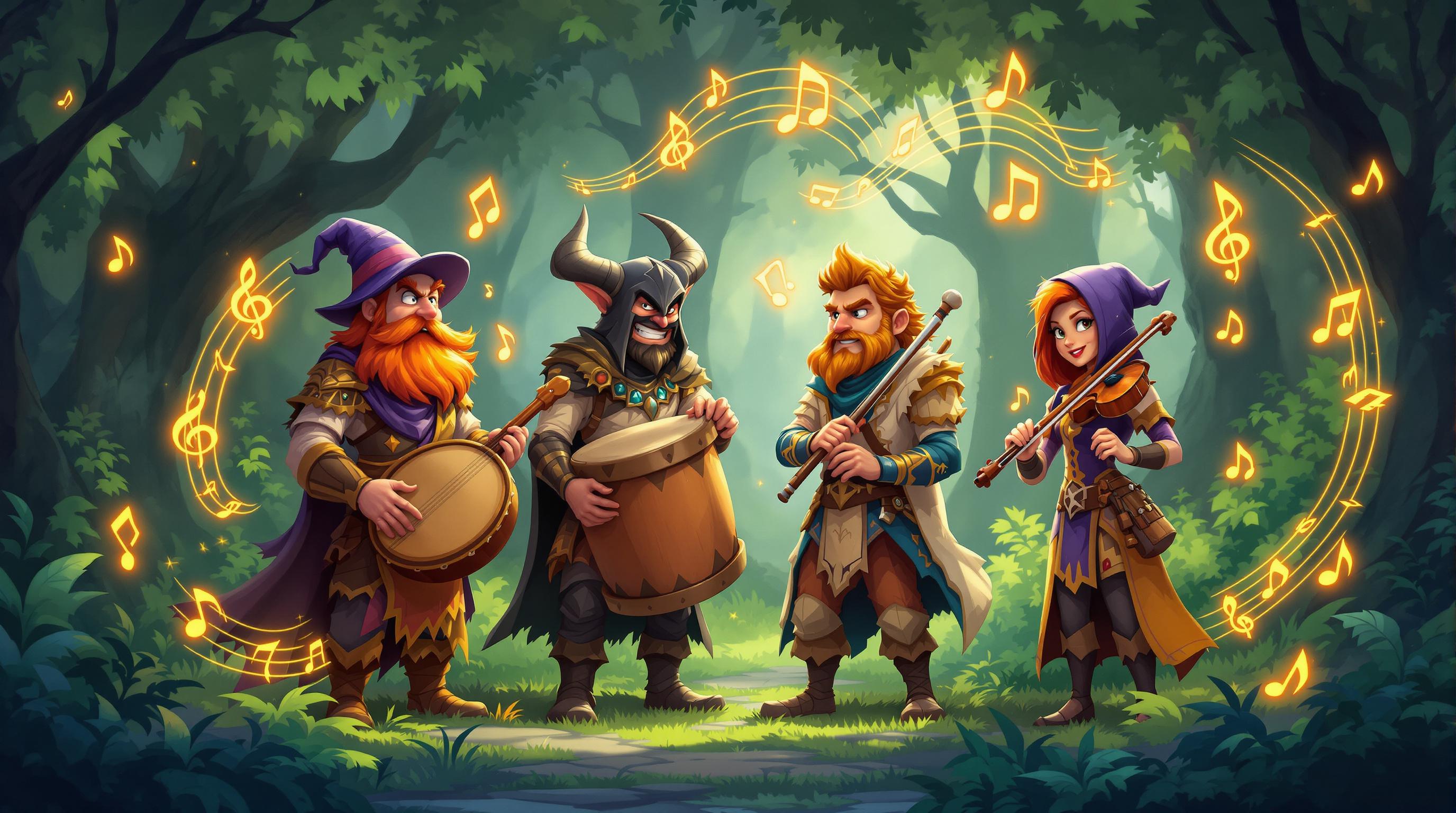NPC (Non-Player Character) motivations are the driving forces behind their actions in tabletop RPGs. These motivations make characters feel real, consistent, and engaging. Here's what you need to know:
-
What Are NPC Motivations?
NPC motivations are shaped by personal goals, external pressures, and past experiences. They guide how NPCs behave and interact with players. -
Why They Matter:
Clear motivations create believable, dynamic characters, enhance storytelling, and allow for organic conflict and meaningful choices. -
How to Create Them:
Use tools like the AIMS system (Agenda, Instinct, Moves, Secrets) or Maslow's hierarchy to design layered motivations. Combine personal desires, external influences, and conflicts for depth. -
Key Categories of Motivations:
- Personal: Basic needs (survival) to complex desires (power, love).
- External: Faction loyalties, societal norms, or environmental pressures.
- Conflict-Driven: Internal struggles or competing priorities.
-
Advanced Techniques:
Mix motivations for complexity, evolve them with player actions, and use them to drive plot twists.
In short, NPC motivations are the foundation of immersive storytelling. They help NPCs grow, adapt, and react naturally to player decisions, making your campaigns more engaging and memorable.
What Makes Complex and Interesting NPCs
Types of NPC Motivations
Creating engaging NPCs starts with understanding what drives them. NPC motivations are the backbone of believable characters and compelling stories. Let’s break down the main categories that shape their behavior.
Personal Motivations
These motivations come from within the NPC - what they want or need on a personal level. These desires influence how they interact with others and make decisions.
| Motivation Level | Examples | Impact on Behavior |
|---|---|---|
| Basic Needs | Survival, shelter, food | Urgent, instinctive actions |
| Complex Needs | Love, status, power, legacy | Thought-out, socially driven decisions |
Think of a noble striving to secure their family’s legacy through political schemes or a merchant focused on maintaining their business and reputation [1].
External Influences
External factors add another layer to NPC behavior, shaping their choices through obligations and pressures. These influences often create tension between personal desires and external expectations.
- Faction Loyalties: An NPC might prioritize their allegiance to a group or cause.
- Societal Expectations: Cultural norms or traditions can heavily dictate actions.
- Professional Duties: Jobs or roles may impose specific responsibilities.
- Environmental Pressures: External events, like disasters or wars, can force decisions.
For example, a soldier may struggle to balance loyalty to their unit with personal beliefs, while a merchant might have to juggle trade alliances and market demands [1][2].
Conflict-Driven Motivations
These motivations emerge from internal or external conflicts, like moral dilemmas or competing priorities. Giving NPCs both strengths and flaws - "one good idea and one bad idea" - can make them feel more dynamic and relatable [2].
Picture an NPC who provides helpful resources but hides a self-serving agenda. This creates tension and adds unpredictability to their interactions with players [1].
With these categories in mind, you’re ready to dive into crafting motivations that bring your NPCs to life.
Steps for Creating NPC Motivations
Using Backstory
An NPC's backstory - shaped by their life events, relationships, and surroundings - lays the groundwork for what drives them. Things like their family history, past hardships, or cultural upbringing can directly shape their values, fears, and decisions.
| Backstory Element | Impact on Motivation | Example |
|---|---|---|
| Family History | Shapes values and priorities | Noble inheritance disputes |
| Past Trauma | Creates fears or obsessions | Betrayal leading to trust issues |
| Cultural Background | Influences beliefs and customs | Traditional values affecting decisions |
Once you’ve nailed down their backstory, you can use the AIMS system to translate these details into clear, actionable motivations.
Applying the AIMS System

The AIMS system breaks down NPC motivations into four key parts:
- Agenda: Their main goals, both short- and long-term.
- Instinct: How they naturally react, shaped by their personality and past.
- Moves: The actions they take to pursue their goals.
- Secrets: Hidden factors that add complexity and intrigue.
Using AIMS, you can create NPCs that respond naturally to player choices, making interactions feel more meaningful.
Incorporating Player Actions
"Understanding the underlying concerns and struggles of NPCs adds depth to your role-playing and makes interactions more realistic and engaging." - Dungeons by Dan, Role-Playing NPCs in D&D: Bringing Your World to Life [1]
NPCs grow and change through their interactions with players. This back-and-forth makes them feel more authentic and engaging.
| Player Action | NPC Response | Motivation Shift |
|---|---|---|
| Assistance | Builds trust | From suspicion to alliance |
| Betrayal | Defensive or vengeful | From neutral to antagonistic |
| Alliance | Shared goals | From individual to group-focused |
sbb-itb-b8b00a5
Advanced Techniques for NPC Motivations
Combining Motivations
Mixing different motivations can result in NPCs that feel more layered and unpredictable. For instance, pairing personal ambition with external demands, like navigating political alliances, creates intriguing conflicts in their decision-making.
| Motivation Type | Internal Factor | External Pressure | Resulting Complexity |
|---|---|---|---|
| Power-driven | Personal ambition | Political alliances | Balances personal desires with the need for diplomacy |
| Protection-focused | Family loyalty | Guild debt | Forces tough choices between safety and obligation |
| Status-oriented | Desire for recognition | Social expectations | Creates tension between self-fulfillment and social norms |
To craft these layered motivations, consider how an NPC’s personal goals might clash with external factors. These conflicts can drive their decisions and behaviors. Start with their core motivations - tools like AIMS can help here - and then introduce these advanced layers for added depth and unpredictability.
Motivations and Plot Twists
Dynamic motivations are excellent for driving unexpected turns in your story. When an NPC’s goals shift in response to events or player actions, it opens the door for natural and engaging plot twists.
| Story Phase | Motivation Shift | Impact on Plot |
|---|---|---|
| Mid-story Reveal | Secret goals revealed | Forces players to rethink alliances and strategies |
| Crisis Point | Motivation conflict peaks | Leads to dramatic, high-stakes decisions |
These evolving motivations can create twists that feel natural. Use key events, player influence, or internal struggles to shift an NPC’s priorities while staying true to their character.
"Make major NPCs w/one good idea & one bad idea... Try to aim them at ways that intersect with player motivations." - Deeper in the Game, "Good Idea, Bad Idea – NPC motivations" [2]
The key is to ensure any shifts in motivation align with the NPC's established personality. This keeps the twists feeling authentic and satisfying, drawing players deeper into the story as they anticipate how the NPC will respond to new challenges.
Resources for NPC Design
Templates and Generators
Game masters have access to several tools to streamline NPC creation and manage their motivations effectively. For instance, the AIMS system provides a structured way to define NPC goals and decision-making, making motivation development easier to handle.
| Tool Type | Purpose | How It Helps with NPC Design |
|---|---|---|
| Campaign Logger | Organization & Tracking | Tracks motivations and maps relationships |
| World Anvil | World Building | Offers character templates and timeline tools |
| Roll20 | Digital Tools | Provides customizable NPC sheets |
These tools aren’t just about filling in blanks - they’re about building NPCs that feel real. Each platform includes features to help you track how your NPCs’ motivations shift and grow over time.
TTRPG Games Directory

In addition to templates and tools, exploring different RPG systems can spark new ideas for crafting NPC motivations. The TTRPG Games Directory highlights various storytelling systems and character-driven mechanics, making it a goldmine for inspiration.
| Game Category | How It Enhances NPC Design |
|---|---|
| Narrative-Driven Games | Offers systems for complex motivations and relationships |
| Classic & Indie RPGs | Combines traditional and creative character-building methods |
Chris Perkins advises focusing on clear goals while staying flexible during NPC design. With these resources, you can ensure your NPCs remain engaging and dynamic without losing their core motivations.
Conclusion: Using NPC Motivations
Key Points
Strong motivations transform NPCs into dynamic characters that bring depth to your tabletop RPG campaigns. The AIMS system provides a structured way to develop NPCs while leaving room for creative storytelling. Paired with detailed backstories and adaptable character growth, this method helps create NPCs with purpose and depth.
"A character's motivation determines their place in their world, their relationships with others, and–most importantly–how they'll interact with your players." [3]
Encouraging Experimentation
Using tools like the AIMS system and blending different motivations can help you design NPCs that grow alongside your story. As mentioned earlier, Maslow's hierarchy is a helpful guide for building layered motivations, ranging from basic needs to more complex desires. These motivations shape NPC behavior and introduce a variety of challenges for players to navigate.
Campaigns like "Shadow Over Silvermore" highlight how layered motivations can drive engaging narratives [1]. The trick is to stay flexible and adapt to player actions while keeping character motivations consistent with your world’s logic.
The most memorable NPCs come from motivations that evolve naturally through interactions with players. Start with clear, simple goals, but let your NPCs adapt and grow as the campaign progresses. By understanding and applying NPC motivations effectively, you’ll craft richer stories and unforgettable moments for your players.


